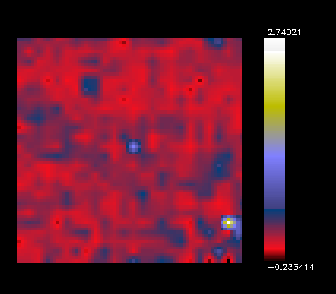
This is an ISOCAM image of the dusty quasar BR1202-0725 through the LW10 filter.
This image is taken from a proposal by K. Leech, P. Barr, A. Salama, R. Saxton, R. Long and B. Altieri and was reduced by B. Altieri.
The distant (z=4.69), dusty quasar BR1202-0725, is believed to be the farthest known object observed by ISO. The quasar (at the center of the image) was detected through the LW10 (8-15 micron) filter of the ISOCAM instrument, along with three other foreground galaxies in the field. Through this filter the object has a flux of approximately 0.7 mJy.
Quasars are the most distant objects yet detected. They give off enormous amounts of energy - the equivalent of more than one hundred normal galaxies combined -, and are believed to be powered by massive central black holes. Energy from quasars takes billions of years to reach the Earth's atmosphere, and thus it provides astronomers with information about the early stages of the Universe.
The word quasar is short for "quasi-stellar radio source", which means star-like emitters of radio waves. Quasars were first detected by their emission in radio waves in the 1960s, and their name is retained today even though astronomers now know most quasars are faint radio emitters. In addition to radio waves and visible light, quasars also emit ultraviolet rays, infrared waves, X-rays, and gamma-rays.